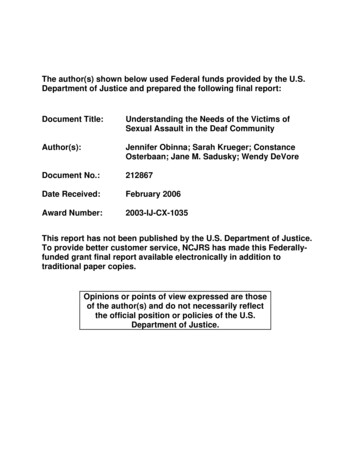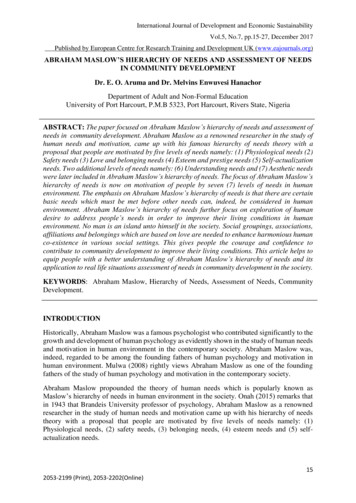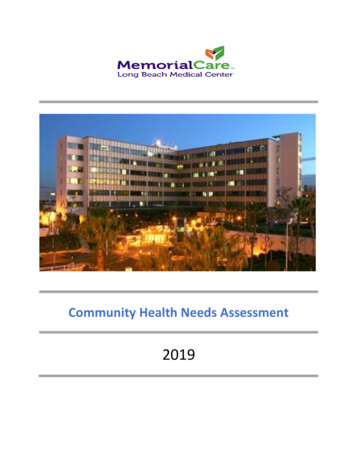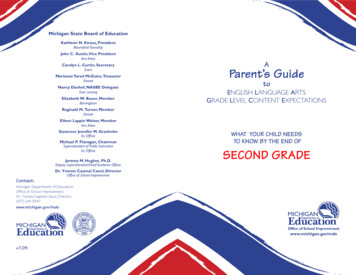
Transcription
The author(s) shown below used Federal funds provided by the U.S.Department of Justice and prepared the following final report:Document Title:Understanding the Needs of the Victims ofSexual Assault in the Deaf CommunityAuthor(s):Jennifer Obinna; Sarah Krueger; ConstanceOsterbaan; Jane M. Sadusky; Wendy DeVoreDocument No.:212867Date Received:February 2006Award Number:2003-IJ-CX-1035This report has not been published by the U.S. Department of Justice.To provide better customer service, NCJRS has made this Federallyfunded grant final report available electronically in addition totraditional paper copies.Opinions or points of view expressed are thoseof the author(s) and do not necessarily reflectthe official position or policies of the U.S.Department of Justice.
This document is a research report submitted to the U.S. Department of Justice. This report has notbeen published by the Department. Opinions or points of view expressed are those of the author(s)and do not necessarily reflect the official position or policies of the U.S. Department of Justice.Understanding the Needs of the Victimsof Sexual Assault in the DeafCommunityA Needs Assessment and AuditResearching Sexual Violence Project (RSVP)Jennifer Obinna, Ph.D., M.S.S.W.Sarah KruegerConstance Osterbaan, Ph.D.Jane M. SaduskyWendy DeVoreCouncil on Crime and Justice822 S. 3rd Street, Suite 100Minneapolis, MN 55415612-596-9470www.crimeandjustice.orgOctober 2005This study was funded with a grant from the United States Department of Justice,National Institute of Justice
This document is a research report submitted to the U.S. Department of Justice. This report has notbeen published by the Department. Opinions or points of view expressed are those of the author(s)and do not necessarily reflect the official position or policies of the U.S. Department of Justice.ADVISORY COMMITTEE MEMBERSJennie Yngsdahl, Rape and Sexual Abuse CenterJude Foster, Sexual Violence CenterMarie Koehler, Deaf & Hard of Hearing ServicesGinny Meyer, SANE NurseKathy Schumaker, Minnesota Employment CenterElise Knopf, Minnesota Employment CenterBev Hull, Perspectives, Inc.Lt. Medaria Arrandondo, Minneapolis Police DepartmentNichole Keltgen, Minnesota Coalition Against Sexual AssaultAndy Sagvold, Council on Crime and JusticeBonnie Cleveland (at large), Sexual Assault Treatment Center, Aurora Sinai Medical CenterAUDIT TEAM MEMBERSJulie Atella, Council on Crime and JusticeWendy Devore, Devore Consulting and Lifetrack ResourcesJennifer Obinna, Audit Team LeaderAudit Coordinator & Research Assistant: Sarah Krueger, Council on Crime and JusticeAudit Consultant: Jane Sadusky, Praxis International, Inc.Interview Coordinator: Kim Wassenaar, ConsultantCouncil on Crime and JusticeOctober 20051
This document is a research report submitted to the U.S. Department of Justice. This report has notbeen published by the Department. Opinions or points of view expressed are those of the author(s)and do not necessarily reflect the official position or policies of the U.S. Department of Justice.Table of ContentsAbstract . 4Executive Summary . 6Review of relevant literature. 9Sexual Assault in the Deaf Community. 10Impact of Sexual Assault . 12Help-seeking Patterns . 13Barriers to Help-seeking . 16Barriers to Help-seeking in the Deaf Community . 20Methodology . 22Needs Assessment. 23Institutional Ethnography Audit . 37Analysis Procedures. 52Findings. 53Effectiveness of PAR Approach . 53Findings from Service Provider Interviews . 54Findings from Community Interviews. 62Analysis of Audit Data . 67Best Practices. 87Conclusions and Recommendations . 93Appendices. 99References. 99Council on Crime and JusticeOctober 20052
This document is a research report submitted to the U.S. Department of Justice. This report has notbeen published by the Department. Opinions or points of view expressed are those of the author(s)and do not necessarily reflect the official position or policies of the U.S. Department of Justice.Community Member Interview Guide. 105Blue Card . 113Council on Crime and JusticeOctober 20053
This document is a research report submitted to the U.S. Department of Justice. This report has notbeen published by the Department. Opinions or points of view expressed are those of the author(s)and do not necessarily reflect the official position or policies of the U.S. Department of Justice.AbstractResearch has just begun to explore sexual violence in culturally diversecommunities. Understanding the impact of sexual violence in culturally Deafcommunities is often overlooked and considered an undeveloped area of inquiry. Suchresearch calls for exploratory approaches using qualitative methods and culturalcompetency when conducting the research activities. Hearing culture tends to defineDeafness as a disability and as such, research has focused on studying disabilitypopulations as a whole without acknowledging the unique character of cultural Deafness.This paradigm may contribute to some of the isolation issues faced by the Deafcommunity.This study examines the perceptions of Deaf and hearing service providers whoassist Deaf individuals with the aftermath of sexual victimization and who individuals inthe Deaf community tell about their experiences of sexual assault. It also deals with why,and what service gaps exist for the Deaf community and what can law enforcement do tobe a more effective resource for members of the Deaf community. A secondary aim ofthis study was to implement a Participatory Action Research (PAR) approach inresearching a sensitive topic in the Deaf community to determine if the PAR approach iseffective.This study has three main outcomes. First, the study provides information to thehearing community regarding Deaf individuals’ perspective on the impact of sexualassault on their community. Second, this study’s results include information on helpseeking patterns in the Deaf community. Third, this study helps to identify the needs ofCouncil on Crime and JusticeOctober 20054
This document is a research report submitted to the U.S. Department of Justice. This report has notbeen published by the Department. Opinions or points of view expressed are those of the author(s)and do not necessarily reflect the official position or policies of the U.S. Department of Justice.Deaf individuals who have been sexually assaulted as well as service gaps affecting thispopulation. Fourth, this study tests the effectiveness of a participatory research model inrecruiting Deaf participants and structuring the study. This study’s results have pertinentapplications in understanding the needs of Deaf persons who have been sexuallyassaulted. Information regarding Deaf individuals’ perceptions of the problem of sexualassault, response to sexual assault, and service gaps to the Deaf community is vital tocreating and sustaining services and policies for the Deaf community.Council on Crime and JusticeOctober 20055
This document is a research report submitted to the U.S. Department of Justice. This report has notbeen published by the Department. Opinions or points of view expressed are those of the author(s)and do not necessarily reflect the official position or policies of the U.S. Department of Justice.Executive SummaryIt is estimated that eighty-three percent of women with disabilities will besexually assaulted in their lifetime (Stimpson & Best, 1991). Moreover, there is evidenceto suggest that women with disabilities are abused by a greater number of perpetratorsand are abused for longer periods of time than non-disabled women (Young, Nosek,Howland, Chapong, & Rintala, 1997). In addition, Deaf and hard of hearing men andwomen may be more likely to have a history of childhood sexual abuse than their hearingcounterparts (Sullivan, Vernon, & Scanlan, 1987).Research is clear that sexual assault and childhood sexual abuse can and oftendoes have a tremendous impact on victims and survivors, both psychologically andphysically. Yet as serious a problem as sexual assault is for Deaf men and women, littleattention has been given to the subject. Current research has just begun to explore theprevalence and consequences of sexual assault among women with disabilities in general,and very little has been done among women with a specific disability or Deafness.As importantly, research has barely begun to address whether persons withspecific disabilities or Deafness seek help after being victimized, who they seek helpfrom, and how service providers and law enforcement officials can be most responsive totheir needs. These are important questions, especially regarding law enforcement. Thenature of a police interaction can have serious implications for the sexual assault victim,can sometimes be a part of her/his experiences unwillingly and can inform future helpseeking with the hearing community.It has also been demonstrated that women with disabilities face an almostCouncil on Crime and JusticeOctober 20056
This document is a research report submitted to the U.S. Department of Justice. This report has notbeen published by the Department. Opinions or points of view expressed are those of the author(s)and do not necessarily reflect the official position or policies of the U.S. Department of Justice.complete lack of understanding by community-based service providers. It seems as ifweighing safety against ongoing care in deciding whether to disclose abuse is a constantstruggle for this population. Deaf women appear to experience profound isolation andlack of options in seeking help. Services are generally unavailable to this group inhearing agencies and suggest that they cannot count on the Deaf community to besupportive in assisting them with abuse issues.Given the isolation issues faced by the Deaf community and that the culturalnature of the Deaf community tends to be overlooked by hearing services, the Council onCrime and Justice applied for and was awarded a grant from the National Institute ofJustice to conduct sexual violence research in the Deaf community. The researchexamines the needs of Deaf individuals in relation to sexual victimization, as well as lawenforcement’s response to Deaf women who seek criminal justice intervention.This is a two-part study combining both an explanatory examination into theneeds of the Deaf community in relation to sexual victimization, and an institutionalethnographic investigation of the Minneapolis Police department’s response to membersof the Deaf community who seek criminal justice intervention for sexual victimization.The needs assessment collected primary data from fifty-one Deaf persons as well asfifteen hearing and Deaf human service providers using open-ended, semi-structuredinterviews. The institutional ethnography of the Minneapolis Police department alsoemployed open-ended, semi-structured interviews with ten law enforcement personnel,observations and text analysis. Specifically, this two-part study addresses five researchquestions. First, what are Deaf people’s perceptions of sexual assault in their community?Second, who do Deaf persons tell about their experiences of sexual assault and why doCouncil on Crime and JusticeOctober 20057
This document is a research report submitted to the U.S. Department of Justice. This report has notbeen published by the Department. Opinions or points of view expressed are those of the author(s)and do not necessarily reflect the official position or policies of the U.S. Department of Justice.they choose them? Third, what service gaps exist? Fourth, what would law enforcementhave to do to be a more appealing resource for victims of sexual assault who are Deaf? Asecondary aim of this study was to see how effective Participatory Action Research(PAR) is in conducting research with an underserved population and in discussing a topicthat may potentially be taboo.Findings suggest that service providers believe sexual assault is a significantproblem in the Deaf community, however, many do not see Deaf clients presenting withsexual assault issues, while others work with many Deaf individuals with abuse histories.Some service providers encourage individuals who are Deaf to call the police upondisclosure, while others are more cautious. It is suggested that with more specializedservices awareness of Deaf culture and improved communication methods, interventionswill be more effective. At the same time it is important to recognize that disclosure toformal support services about abuse may be hindered by the intimacy that exists in theDeaf community.Several themes emerged from the community interviews with Deaf men andwomen. Whether participants were discussing the event in the scenario or sharing theirown stories, the feelings of fear, anger, shock, disappointment, embarrassment and selfblame are prevalent. Family members were sometimes seen as sources of strength andsometimes were not, usually depending upon whether or not parents were also Deaf.Police are almost always thought of as a place to call for help and yet, many discussexperiences in which contact with the police was frustrating. Few survivors even calledthe police after their experience with sexual abuse. In the “date rape” scenario manymade comments about why the victim allowed her “date” to come into her home afterCouncil on Crime and JusticeOctober 20058
This document is a research report submitted to the U.S. Department of Justice. This report has notbeen published by the Department. Opinions or points of view expressed are those of the author(s)and do not necessarily reflect the official position or policies of the U.S. Department of Justice.only 3 dates, however, no one blamed her for what happened.The institutional ethnography reveals areas where the Minneapolis PoliceDepartment experiences challenges when it comes to communication with Deaf persons,whether as a victim, witness or suspect. Though there are policies and procedures forlocating interpreters, little specific training about on-scene communication and initialrecognition of whether someone is Deaf is provided. In addition, the links between thepolice department and Deaf community members are not well-developed. Unfortunately,due to reporting practices, it is difficult to obtain a reliable picture of the frequency andextent of police interaction with persons who are Deaf. Even with all of these challenges,it is important to note that the Minneapolis Police Department can be characterized as a“model” jurisdiction in serving members of the Deaf community.Findings from this investigation highlight areas of focus for both policy makersand service delivery systems. It is our hope that further research in this area will helpbuild a theoretical framework for understanding help-seeking patterns and behaviorwithin the Deaf community and that the ethnography can produce a tool that can be usedin other jurisdictions that are interested in better understanding their capacity to executebest practices as first responders to Deaf victims. Findings also reveal that the PARapproach to research is a promising practice to use and may have applications inconducting research in other cultural communities.Review of relevant literatureResearch exploring the prevalence and consequences of sexual assault amongwomen with disabilities is generally limited.Council on Crime and JusticeOctober 20059
This document is a research report submitted to the U.S. Department of Justice. This report has notbeen published by the Department. Opinions or points of view expressed are those of the author(s)and do not necessarily reflect the official position or policies of the U.S. Department of Justice.Research has barely begun to address whether women with specificdisabilities seek help after being victimized, who they seek help from, andhow service providers and law enforcement officials can be mostresponsive to their needs. [A woman’s] ability to recognize her experienceas abusive, seek help, protect herself, remove herself from the abusivesituation, or discover some other way to resolve the abuse are all verymuch affected by her disability and the limitations imposed by barriers inher environment (Nosek, 2001).One study found that eighty-three percent of women with disabilities would be sexuallyassaulted in their lifetime (Stimpson & Best, 1991). Moreover, there is evidence tosuggest that women with disabilities are abused by a greater number of perpetrators andare abused for longer periods of time than non-disabled women (Young, Nosek,Howland, Chapong, & Rintala, 1997). Research does demonstrate that amongdevelopmentally disabled women, for example, of those who report being victims ofabuse, 49% experienced 10 or more incidents of abuse (Valenti-Heim, 1995).Sexual Assault in the Deaf CommunityIt is estimated that approximately 22 million individuals in United Statesexperience hearing loss (Williams & Abeles, 2004). It has also been suggested thatapproximately 10% of the U.S. population is Deaf or hard of hearing (Stimpson & Best,1991). Three in every one thousand births in the United States are children with somedegree of neonatal hearing loss, with one third having profound hearing loss or Deafness(Samson-Fang, Simons-McCandless & Shelton, 2000). Though individuals with hearingloss and Deafness sometimes share similar characteristics, those with the onset ofprofound hearing loss or Deafness at birth or at a young age often share a commonculture and language. It is estimated that between 200,000 and 500,000 individuals in theUnited States are culturally Deaf (Williams & Abeles, 2004).Council on Crime and JusticeOctober 200510
This document is a research report submitted to the U.S. Department of Justice. This report has notbeen published by the Department. Opinions or points of view expressed are those of the author(s)and do not necessarily reflect the official position or policies of the U.S. Department of Justice.Deaf individuals who are sexual assault survivors face multiple barriers andstereotypes due to their status as a Deaf individual, as a sexual assault victim, and alsodue to the male or female gender stereotypes associated with their status as a sexualassault survivor. As with other disability groups, the Deaf community experiencessignificant barriers in communication with the general hearing population and has limitedaccess to media information that hearing people take for granted (Modry, 1994).Traditionally, research on Deaf individuals has incorporated a medical model, which hasfocused on deficits in function, on hearing loss, instead of recognizing the communitieslinguistic and cultural minority status (Glickman, 1996).Sadusky & Obinna (2002) found that Deaf women do not necessarily seethemselves as having a disability, but as having a culture and way of communicating thatis denied by the dominant hearing culture. Deaf women do not necessarily share the sameperceptions and opinions about what would be an appropriate response to domestic andsexual violence. At the same time, there appears to be cultural distinctions between thosewho consider themselves “Big-D” Deaf (culturally Deaf), versus others who are referredto as “small-d” non-culturally deaf (Sadusky & Obinna, 2002).Deaf individuals may be more likely to have a history of childhood sexual abusethan their hearing counterparts (Sullivan, Vernon, & Scanlan, 1987). An often quoted1987 study, one of the few of its type, indicated the level of sexual victimization prior toadulthood to be 50% of all Deaf individuals as compared to 25 % of hearing females and10% of hearing males (Sullivan, Vernon & Scanlon, 1987).A survey of 598 battered women’s programs found that programs were leastlikely to serve women with visual or hearing impairments as compared to other womenCouncil on Crime and JusticeOctober 200511
This document is a research report submitted to the U.S. Department of Justice. This report has notbeen published by the Department. Opinions or points of view expressed are those of the author(s)and do not necessarily reflect the official position or policies of the U.S. Department of Justice.with disabilities (Center for Research on Women with Disabilities, 2002). A recent study,conducted by Rainbow Research in 2002, included two focus groups with Deaf and hardof hearing women who reported that services in hearing agencies were generallyunavailable to them, andDeaf women cannot necessarily count on the larger Deaf community to besupportive, particularly if the victim and perpetrator are Deaf. Isolationand communication are significant issues. Women cannot count on serviceagencies to even know what to do with a TTY [text telephone] Relianceon interpreters means giving up your privacy and sharing intimate detailsof your life with a stranger. Deaf women cannot count on interpreters toaccurately represent their words and experience (Sadusky & Obinna,2002).Research clearly indicates that there is a disparity not only in the prevalence of sexualviolence in the Deaf community but in the amount of support that Deaf individuals canaccess.Research in the Deaf community presents unique challenges. The Deafcommunity has been typified as a “small, closed system with a strong sense ofconformity” (Modry, 1994). As such, it may possess more rigid values, stereotypes, andsocial dictates than in the mainstream hearing culture (Williams & Abeles, 2004).Impact of Sexual AssaultResearch is clear that rape and sexual abuse can and often do have a tremendousimpact on victims and survivors, both psychologically and physically (Atkinson,Calhoun, Resick, & Ellis, 1982; Burgess & Holstrom, 1979; Ellis, 1983; Kilpatrick,Veronen, & Resick, 1979 & 1981). In examining the immediate consequences of rape,researchers conclude that responses during the first 3–4 months post-rape include intensefeelings of anxiety and fear (Burgess & Holstrom 1974 & 1979; Kilpatrick et al., 1979);Council on Crime and JusticeOctober 200512
This document is a research report submitted to the U.S. Department of Justice. This report has notbeen published by the Department. Opinions or points of view expressed are those of the author(s)and do not necessarily reflect the official position or policies of the U.S. Department of Justice.physical and psychiatric symptoms (Atkinson et al., 1982; Kilpatrick et al., 1979); anddifficulty with social adjustment (Atkinson et al., 1982; Burgess & Holstrom, 1974 &1979; Kilpatrick et al., 1979 & 1981). However, it is estimated that a small minority ofsurvivors engage in help-seeking using formal supports and services. Approximately 5%of adult rape victims report recent rape attacks to the police and 5% seek rape crisiscenter services (Koss, Gidycz, & Wisniewski, 1987; Fisher, Cullen & Turner, 2000).Help-seeking PatternsCoping actions, broadly conceived, can be classified into two categories: thosethat are taken alone, and those in which one enlists aid from others such as friends,family, neighbors, the criminal justice system and mental health workers. (Frieze, Hymer& Greenberg, 2003). Aid from others, regardless of its form, appears to be an importantcomponent of victims' ability to cope with victimization (Bard & Sangrey, 1986).Research has also indicated that support from family, friends, the helping and legalprofessions, and the community at large has also been vital in the recovery andreadjustment of crime victims (Bard & Sangrey, 1986; Krupnick & Horowitz, 1981;Symonds, 1980).Positive social support after victimization can maintain and enhance self-esteem,according to a number of researchers (Cobb, 1976; Kutash, 1978; Silver & Wortman,1980). Friedman (1982) reported that the more supporters victims had, the sooner theygot over the posttraumatic stress of victimization. Positive social support can make theindividual feel cared for and esteemed (Cobb, 1976).Council on Crime and JusticeOctober 200513
This document is a research report submitted to the U.S. Department of Justice. This report has notbeen published by the Department. Opinions or points of view expressed are those of the author(s)and do not necessarily reflect the official position or policies of the U.S. Department of Justice.Social support appears to protect people in crisis from a variety of pathologicalstates including physical illnesses, depression and alcoholism. Much research indicatesthat support from family, friends, the helping and legal professions, and the community atlarge is vital in the recovery and readjustment of crime victims (Bard & Sangrey, 1986;Krupnick & Horowitz, 1981; Symonds, 1980). Support providers are often categorized intwo groups, informal and formal. The former may consist of relatives, friends, neighbors,or bystanders, and the latter, professional helpers such as the police, medical, or mentalhealth personnel (Gottfredson, Reiser, & Tsegaye-Spates, 1987).Informal Support Systems. Victims and survivors tend to turn to friends as themost common source for social support following an assault. Ullman (1996), studiedwhether the type of positive and negative social reactions by significant others had asignificant effect on sexual assault victims’ adjustment. He found that friends are themost common support source for sexual assault victims and that positive emotionalsupport and neutral support from friends are associated with better recovery.For rape victims social support may be of especially significant importancebecause of the common negative reactions of their husbands or lovers (Frieze, 1983;Russell, 1974; Silverman, 1978). According to some studies, rape victims often find thattheir own reactions to their rapes are quite different from those of men with whom theyare associated. Miller and Williams (1979) found that rape victims often react to thecrime with fear, guilt, or anger and hostility toward men, while their male partners aremore likely to feel anger or rage. Differing reactions may lead to a lack of empathy forone another and produce other problems in communication between the couple, and inthese instances, other social support may be especially critical.Council on Crime and JusticeOctober 200514
This document is a research report submitted to the U.S. Department of Justice. This report has notbeen published by the Department. Opinions or points of view expressed are those of the author(s)and do not necessarily reflect the official position or policies of the U.S. Department of Justice.The centrality of informal support systems is further enhanced by the findings ofDobash et al., which suggest that women may delay seeking help from statutory (formal)agencies until other avenues of support have been accessed (1985). Another factorinfluencing an individual’s decision to access formal support is the influence of informalsupport systems. Informal support systems may play a central role in an individual’sdecision to access or not access formal (legal) support systems. One study reported thatan important factor in the decision of whether to report a crime or not is the influenceexerted by others on the victims regarding the decision (Greenberg, Ruback, & Westcott,1982). The decision to notify the police is not made in a social vacuum (Ruback,Greenberg, & Westcott, 1984) and in fact, the victim may be unusually susceptible to theinfluence of others. Interviews with crime victims show that a considerable number ofthem have consulted with and received advice from others about what to do (Greenberget al., 1982; Spelman & Brown, 1981). Rape victims who contact rape crisis centers areeven more likely than other victims to consult with others before calling the police. Somedata suggests that victims are more inclined to accept the advice of others if the other is aco-victim who offers to support the victim in his or her future dealing
their needs. These are important questions, especially regarding law enforcement. The nature of a police interaction can have serious implications for the sexual assault victim, can sometimes be a part of her/his experiences unwillingly and can inform future help-seeking with the hearing community.











